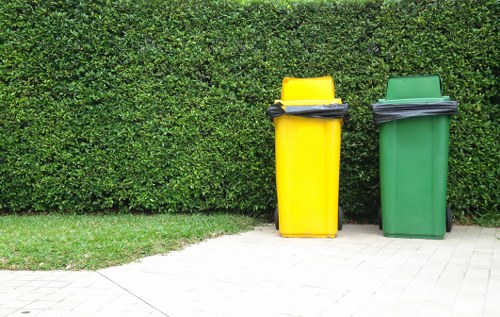Comprehensive Guide to Garden Clearance in House Clearances

Understanding Garden Clearance
Garden clearance is an essential aspect of house clearances, ensuring that outdoor spaces are free from unwanted debris and overgrown vegetation. Whether you're preparing to sell your home, downsizing, or simply wanting to refresh your garden, a thorough garden clearance can make a significant difference.
Proper garden clearance not only enhances the aesthetic appeal of your property but also promotes a healthier environment by removing potential hazards such as dead plants, fallen branches, and litter. It involves the systematic removal of plants, trimming of overgrown areas, and ensuring that the garden is clean and presentable.
Engaging in garden clearance can also contribute to the overall maintenance of your property, preventing issues like pest infestations and plant diseases that thrive in cluttered environments. By committing to regular garden clearances, homeowners can maintain a beautiful and functional outdoor space year-round.

Benefits of Professional Garden Clearance
Expertise and Efficiency
Hiring professionals for garden clearance ensures that the job is done efficiently and effectively. Experienced garden clearance services have the necessary knowledge and tools to handle various challenges, from removing large debris to managing overgrown areas. Their expertise allows for a thorough clearance, leaving your garden spotless.
Time-Saving
Garden clearance can be time-consuming, especially for large or neglected gardens. Professional services can complete the task much quicker than an individual, allowing you to enjoy your garden without the prolonged hassle of clearing it yourself.
Safety
Clearing a garden can involve handling sharp tools, heavy equipment, and potentially dangerous debris. Professionals are trained to manage these risks safely, reducing the likelihood of accidents and injuries during the clearance process.
- Expert handling of tools and equipment
- Safe removal of hazardous materials
- Minimized risk of injury

Steps Involved in Garden Clearance
Assessment and Planning
The first step in garden clearance is assessing the current state of your garden. Professionals will evaluate the extent of overgrowth, types of plants, and any existing hazards. Based on this assessment, a clear plan is formulated to address all necessary aspects of the clearance.
Removing Debris and Unwanted Materials
Once the assessment is complete, the next step involves the removal of debris such as fallen branches, dead plants, and litter. This process may also include the disposal of green waste and ensuring that the garden is free from any unwanted materials.
Trimming and Pruning
Trimming overgrown plants and pruning trees and shrubs are crucial for maintaining the health and appearance of your garden. Proper pruning helps in promoting new growth and preventing diseases, ensuring that your garden remains vibrant and well-maintained.
- Initial assessment of the garden
- Debris and waste removal
- Trimming and pruning of plants

Eco-Friendly Garden Clearance Practices
Recycling and Reuse
Eco-friendly garden clearance emphasizes recycling and reusing materials wherever possible. Instead of disposing of all waste, professionals can sort out materials that can be recycled or repurposed, reducing the environmental impact of the clearance process.
Composting
Organic waste generated during garden clearance, such as leaves and grass clippings, can be composted to create nutrient-rich soil. Composting not only minimizes waste but also contributes to the health of your garden by providing natural fertilizers.
Minimizing Carbon Footprint
Using sustainable methods and energy-efficient equipment during garden clearance helps in minimizing the carbon footprint. Professionals committed to eco-friendly practices ensure that the clearance process is as green as possible.
- Sorting and recycling materials
- Composting organic waste
- Using energy-efficient tools

Choosing the Right Garden Clearance Service
Experience and Reputation
When selecting a garden clearance service, experience and reputation are key factors to consider. Look for companies with a proven track record of delivering high-quality clearance services and positive customer feedback.
Range of Services
Ensure that the service provider offers a comprehensive range of garden clearance services, including debris removal, trimming, pruning, and waste disposal. A full-service provider can handle all aspects of the clearance, providing convenience and efficiency.
Pricing and Value
Compare pricing structures among different garden clearance services to ensure you are getting good value for your money. While cost is an important consideration, prioritize quality and reliability to achieve the best results for your garden.
- Research and compare service providers
- Check for comprehensive service offerings
- Evaluate pricing and value
Maintaining Your Garden Post-Clearance
After completing a garden clearance, ongoing maintenance is essential to keep your garden in pristine condition. Regular upkeep prevents overgrowth and reduces the need for extensive clearances in the future.
Implementing a maintenance schedule that includes routine trimming, weeding, and debris removal can significantly contribute to the longevity and beauty of your garden. Additionally, proper watering and fertilization practices ensure that your plants remain healthy and vibrant.
Consider investing in smart gardening tools and techniques to make maintenance easier and more efficient. By staying proactive, you can enjoy a well-maintained garden all year round.
Establishing a Routine
Set a regular schedule for garden maintenance activities such as mowing, pruning, and weeding. Consistency is key to preventing the accumulation of debris and overgrown plants.
Using Quality Tools
Investing in high-quality gardening tools can make maintenance tasks easier and more effective. Tools like sharp pruners, durable shears, and reliable mowers can help keep your garden looking its best.
Seasonal Care
Different seasons require different maintenance approaches. For instance, spring might involve planting new growth, while autumn focuses on preparing the garden for winter. Adapting your maintenance routine to seasonal changes ensures that your garden remains healthy and attractive throughout the year.
- Create a maintenance schedule
- Invest in quality gardening tools
- Adapt maintenance tasks to seasonal needs
Common Challenges in Garden Clearance
Dealing with Large Trees
Removing or trimming large trees can be particularly challenging due to their size and the complexity of the job. It often requires specialized equipment and expertise to ensure that the task is completed safely and effectively.
Managing Overgrown Vegetation
Overgrown vegetation can quickly become unmanageable, especially in neglected gardens. Tackling extensive overgrowth involves careful planning and persistent effort to restore the garden to its desired state.
Handling Hazardous Materials
Sometimes, garden clearance may involve dealing with hazardous materials such as pesticides, diseased plants, or broken glass. Proper handling and disposal of these items are crucial to maintain a safe and healthy garden environment.
- Safety concerns with large trees
- Time-consuming overgrown areas
- Proper disposal of hazardous waste
Cost Factors in Garden Clearance
Size of the Garden
The size of your garden plays a significant role in determining the cost of clearance. Larger gardens require more time, labor, and resources, leading to higher overall costs.
Extent of Overgrowth
Gardens with extensive overgrowth or significant debris accumulation will naturally incur higher clearance costs. Intensive removal efforts necessitate additional labor and time, which can impact the final price.
Accessibility and Location
The accessibility of your garden and its location also affect the cost. Gardens that are difficult to access or located in remote areas may require specialized equipment or longer travel times, contributing to increased expenses.
- Assess garden size
- Evaluate level of overgrowth
- Consider accessibility and location
Legal Considerations in Garden Clearance
When undertaking garden clearance, it's important to be aware of any local regulations or permits that may be required. Certain areas may have specific guidelines regarding waste disposal, tree removal, and the handling of hazardous materials.
Waste Disposal Regulations
Ensure that all waste materials are disposed of in accordance with local laws. Improper disposal can lead to fines and environmental harm. Professional garden clearance services are typically well-versed in these regulations and can manage waste disposal appropriately.
Tree Removal Permits
In many regions, removing certain types or sizes of trees may require permits. It's essential to check with local authorities before proceeding with tree removal to avoid legal complications.
Environmental Protections
Be mindful of protected plant species and environmental conservation laws. Clearing gardens without considering these factors can result in penalties and negatively impact local ecosystems.
- Understand local waste disposal laws
- Obtain necessary permits for tree removal
- Respect environmental protection guidelines
DIY vs. Professional Garden Clearance
Pros of DIY Garden Clearance
Opting for a DIY approach to garden clearance can be cost-effective and give you complete control over the process. It allows you to tailor the clearance to your specific preferences and pace.
Cons of DIY Garden Clearance
However, DIY garden clearance can be time-consuming and physically demanding. Without the proper tools and expertise, you may encounter challenges that can lead to incomplete clearance or potential safety hazards.
When to Hire Professionals
Hiring professionals is advisable when dealing with large-scale clearances, hazardous materials, or when you lack the time and resources to undertake the task yourself. Professionals can ensure that the clearance is done thoroughly and safely.
- Evaluate the scope of the clearance
- Consider time and physical constraints
- Assess the need for specialized tools or expertise
Tools and Equipment for Garden Clearance
Having the right tools and equipment is crucial for efficient garden clearance. Whether you're doing it yourself or relying on professionals, the right gear can make a significant difference in the outcome.
Essential Tools
Essential tools for garden clearance include pruning shears, loppers, hedge trimmers, and shovels. These tools help in trimming plants, removing debris, and managing soil effectively.
Heavy Equipment
For larger gardens, heavy equipment like skid steer loaders, chainsaws, and wood chippers may be necessary. These machines can handle more substantial tasks, such as removing large trees and processing bulky waste.
Safety Gear
Safety gear, including gloves, helmets, protective eyewear, and sturdy footwear, is vital to protect yourself from potential injuries during the clearance process.
- Pruning and trimming tools
- Heavy machinery for large-scale tasks
- Protective safety equipment
Seasonal Considerations for Garden Clearance
Spring Clearing
Spring is an ideal time for garden clearance as it prepares the garden for the growing season. Removing dead plants and clearing debris can encourage new growth and a vibrant garden.
Autumn Maintenance
Autumn garden clearance focuses on preparing the garden for winter. This includes removing fallen leaves, trimming perennials, and safeguarding plants against harsh weather conditions.
Summer Upkeep
During summer, garden clearance involves regular maintenance to control weeds, manage overgrowth, and ensure plants are healthy and well-watered despite the warmer temperatures.
- Plan clearance activities around seasonal changes
- Tailor clearance tasks to specific seasonal needs
- Ensure year-round garden health and beauty
Environmental Impact of Garden Clearance
Garden clearance, when done thoughtfully, can have a positive environmental impact. Proper disposal and recycling reduce waste, while maintaining a healthy garden supports local biodiversity.
Supporting Local Wildlife
A well-maintained garden can provide habitats for local wildlife. By clearing invasive species and planting native plants, you can enhance the biodiversity of your garden and support pollinators and other beneficial creatures.
Reducing Waste
Effective garden clearance reduces the amount of waste sent to landfills. Composting organic matter and recycling materials where possible contribute to a more sustainable environment.
Sustainable Practices
Incorporating sustainable practices, such as using eco-friendly tools and minimizing chemical usage, ensures that garden clearance benefits both the environment and your garden's health.
- Enhance biodiversity
- Implement recycling and composting
- Adopt sustainable gardening practices
Final Thoughts on Garden Clearance
Garden clearance is a vital component of house clearances, playing a significant role in maintaining the beauty, safety, and functionality of your outdoor space. Whether you choose to undertake the clearance yourself or hire professionals, understanding the process and its benefits can help you achieve the best results.
Investing in regular garden clearance not only enhances the appeal of your property but also fosters a healthy and sustainable environment. By following best practices and considering seasonal and environmental factors, you can enjoy a thriving garden all year round.
Take the first step towards a cleaner, more beautiful garden today. Contact us today to book your garden clearance service and transform your outdoor space.